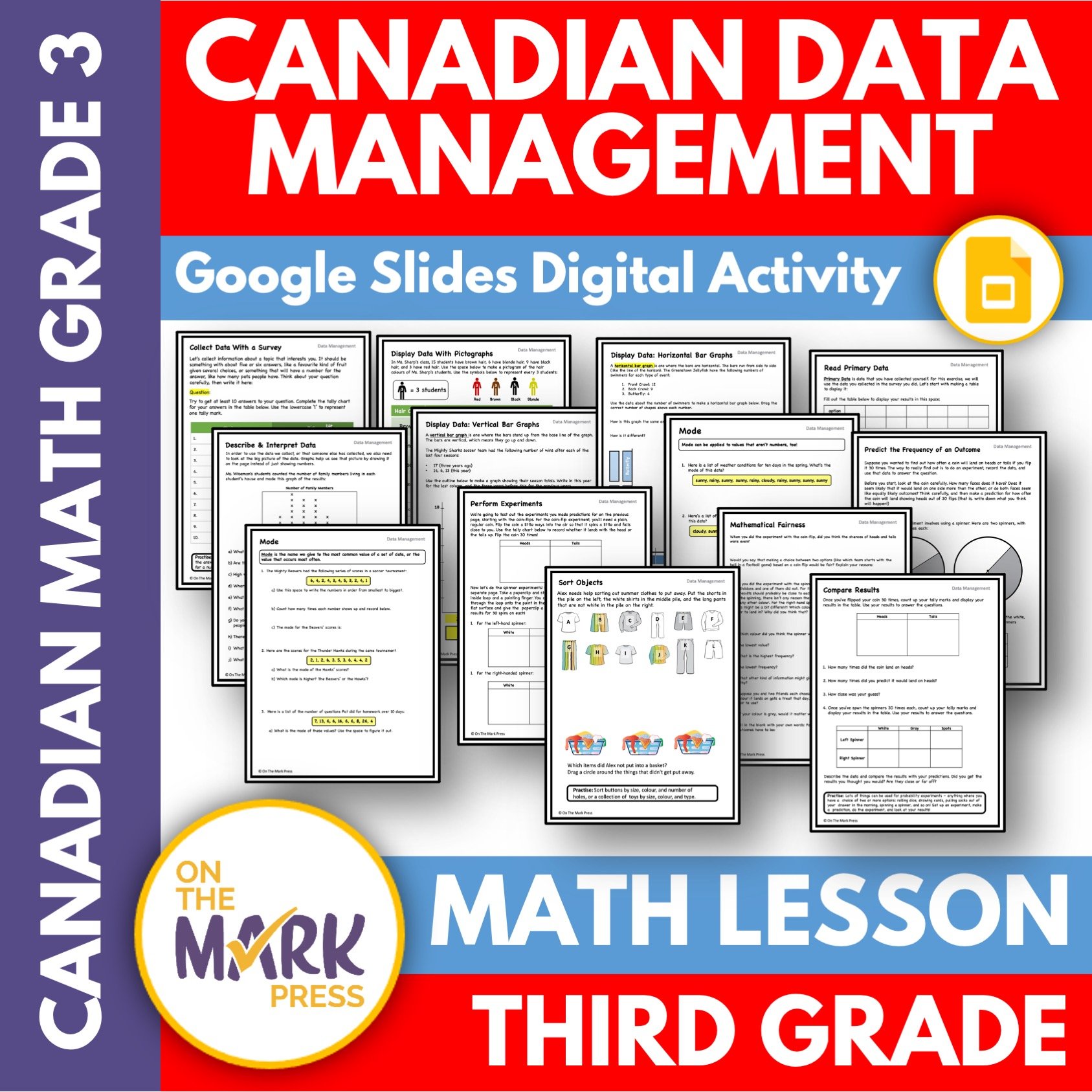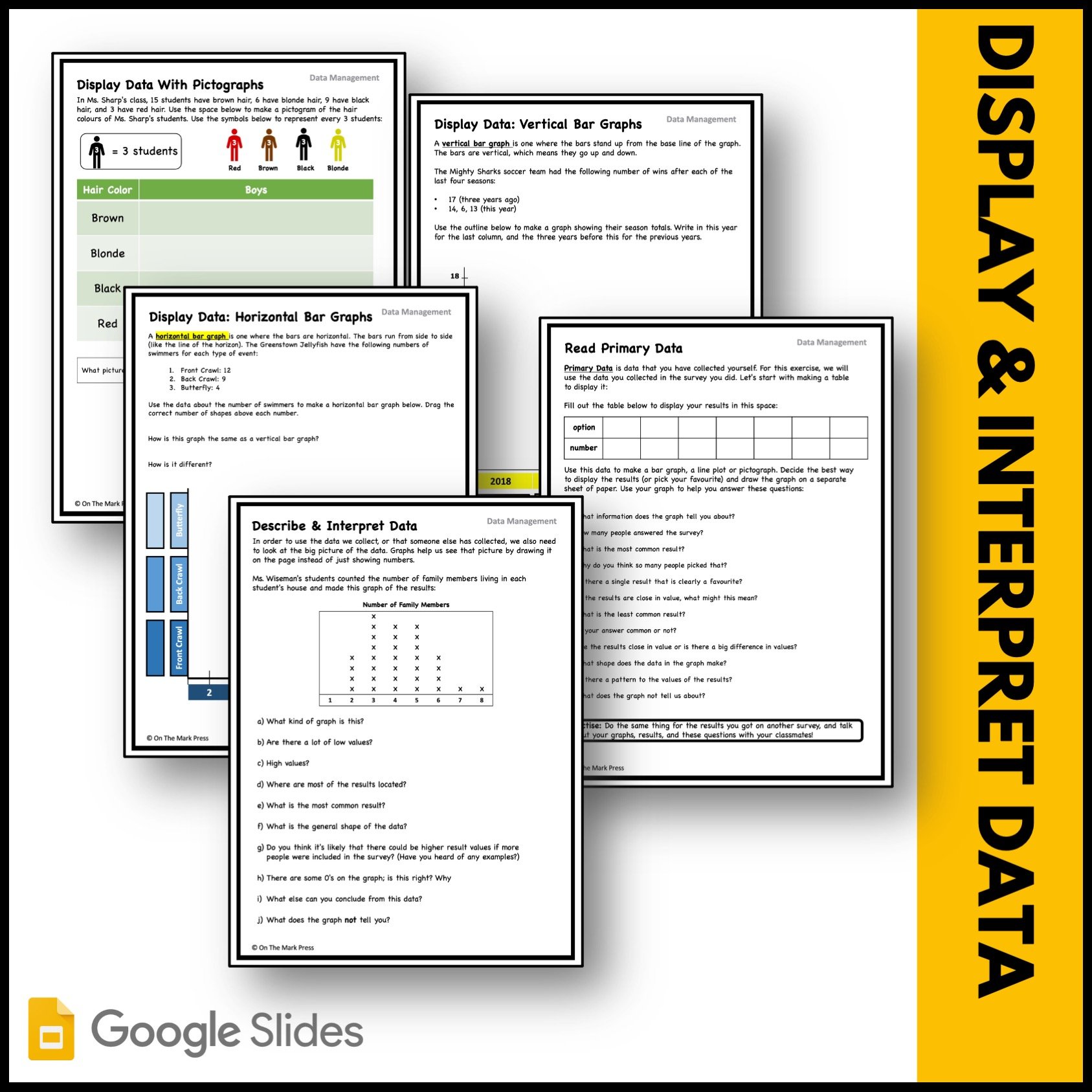Grade 3 Data Management - Info for Parents
When I was in Grade 3, I don’t think I ever heard the term Data Management used at school or at home. Nowadays, it is a term used frequently within schools. In this blog, EZ-Teach will answer some questions parents have about Grade 3 Data Management including what it is, what is expected of students at this level, tips for teaching it, and what sort of curriculum is available. Here are the topics we will cover:
Ok, let’s review the basics of Grade 3 Data Management. Click on the links to learn more or feel free to contact us if you have other questions.
In Grade 3 Data Management, students learn to work with data, including its representation and interpretation.
Image Source: Jessica Lewis Creative
Basics of Grade 3 Data Management
1. Data Management
Let’s first begin by explaining what data management is. According to the Ontario Curriculum Guides for Grade 3 Math, Data Management is about data literacy. Students will learn to develop an understanding of data, including the following ways of interacting with it:
Collecting Data
Organizing Data
Displaying Data
Interpreting Data (involving large numbers)
They will also work with scales on graphs, use averages to compare data, make predictions and form conclusions based on the interpretation of data.
Overall, Grade 3 Data Management in Ontario involves two broad categories: Data Literacy (collection and organization of data, data relationships) + Probability.
Grade 3 Data Management involves fun activities like creating and designing graphic representations.
Image Source: Sarah Dietz
2. Grade 3 Expectations
After learning what Data Management is, you may think that this involves pretty advanced math work for a student in Grade 3, right? Well, let’s look at what level of comprehension is expected for Grade 3 Data Management.
We’ve summarized and highlighted the expectations listed in A Guide to Effective Instruction in Mathematics, Kindergarten to Grade 3 – Data Management and Probability and in the current Ontario Curriculum Strands. Here is what is expected of a student at this level.
Students are able to:
Sort and classify objects (e.g. beads or candy) according to more than one feature (colour, size, etc.) at the same time
Determine and explain the rules of sorting objects
Collect data using surveys
Organize and record data through a variety of methods (e.g. tallying)
Create charts, bar graphs (vertical & horizontal), pictographs, and tables to present data
Display and understand the need for labels, symbols, scales, and titles.
Determine mean and mode
Describe and compare data represented in graphic organizers
Draw conclusions about the data defined and understand how data proves or disproves
Describe and compare the probability of events using mathematical terms (e.g. likely, less likely)
Predict the frequency of outcomes using games or experiments
Make and test predictions about the mean and mode of data from different populations.
For more information about what is expected, visit the two documents listed above. In the first guide, you can also see some examples of the types of graphs students use such as Venn Diagrams and templates you can use with students. These practice templates are helpful if you want to review data literacy with your children or students in preparation for the EQAO testing.
When sorting and classifying objects, bring in fun and memorable items like candy to calm any math anxiety.
Image Source: Foodie Factor
3. Helpful Teaching Techniques
Some kids will dread math, so it is important for them to see that studying math and working with data can be fun. Try the following:
Use games that involve having kids use spinners when teaching probability (Note: A spinner is a pie chart that has a spinnable arrow that can be spun and will randomly land on a piece of the pie)
Involve food when you are talking about graphs… pie anyone?
When sorting objects, let students choose objects they are familiar with and enjoy collecting (e.g. This is a great opportunity to find out what kids collect)
Or, let them sort candy - that will likely be a huge hit!
When collecting data, let students do surveys and ask questions about their real-life interests (e.g. They can find out which character is the most popular in their favourite show or movie)
Let kids complete graphs in small groups and present their data with the colourful graphs they’ve created. By working in a group, they will help each other draw conclusions about the data they are interpreting
Teaching the concepts required for Grade 3 Data Management only goes so far, so giving students practice working with data, experimenting, and even coming to some interesting and strange (or wrong) conclusions about the data they see will help make the concepts more relatable, real and memorable. They’ll remember the time they got to sort out the different coloured gummy worms and how surprised they were that their class’s favourite gummy worm was the small red and yellow one.
Click on the image to be taken to our product page for this Grade 3 Data Management curriculum.
4. Data Management Curriculum
Unless you’ve skipped ahead to this section of the blog, you’ll notice that there are some helpful curriculum resources in the Guide, A Guide to Effective Instruction in Mathematics, Kindergarten to Grade 3 – Data Management and Probability. Plus, we’ve provided a link to the Ontario Curriculum Webpage which describes the expectations related to Grade 3 Data Management. This will help teachers and homeschooling parents create yearly plans and look for curriculum.
In this section, we’d like to highlight the curriculum from On the Mark Press that we have available right here on our website!
Canadian Data Management, Google Slides - Grade 3
This curriculum is designed as a set of 12 third-grade data management lesson plans which have been created as Google Slides. You can download the material and present it in class. The slides include lessons on:
Displaying Data
Describing & Interpreting Data
Predicting the Frequency of an Outcome
Reading Primary Data - and more!
This product can be downloaded straight from our site and costs only $6.95. If you want to read more about this curriculum and/or purchase it, click here. You can also view our other Math Curriculum here which includes a link to the Grades 1-4 Data Management lessons.
Click on the images to see the lessons in the Grade 3 Data Management curriculum by On The Mark Press.
EZ-Teach
We hope that, whether you are a teacher or a parent, this resource has helped you understand what is expected in Grade 3 Data Management and that it has provided you with some inspiration for how to teach it.
Please visit our Curriculum page for more digital resources or read our blog for other information and tips.
Feel free to contact us or explore our site to learn more about us. We are growing and adding gradually to our site and are glad you’ve taken the time to visit. Take Care!







